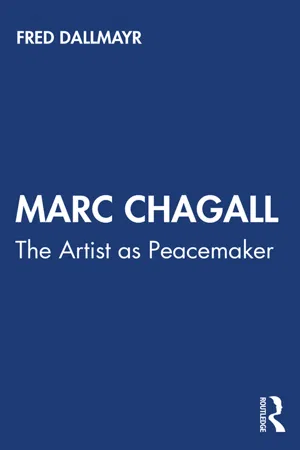
- 70 pages
- English
- ePUB (mobile friendly)
- Available on iOS & Android
About this book
This book follows Chagall's life through his art and his understanding of the role of the artist as a political being. It takes the reader through the different milieus of the nineteenth and twentieth centuries – including the World Wars and the Holocaust – to present a unique understanding of Chagall's artistic vision of peace in an age of extremes. At a time when all identities are being subsumed into a "national" identity, this book makes the case for a larger understanding of art as a way of transcending materiality. The volume explores how Platonic notions of truth, goodness, and beauty are linked and mutually illuminating in Chagall's work. A "spiritual-humanist" interpretation of his life and work renders Chagall's opus more transparent and accessible to the general reader.
It will be essential reading for students of art and art history, political philosophy, political science, and peace studies.
Frequently asked questions
- Essential is ideal for learners and professionals who enjoy exploring a wide range of subjects. Access the Essential Library with 800,000+ trusted titles and best-sellers across business, personal growth, and the humanities. Includes unlimited reading time and Standard Read Aloud voice.
- Complete: Perfect for advanced learners and researchers needing full, unrestricted access. Unlock 1.4M+ books across hundreds of subjects, including academic and specialized titles. The Complete Plan also includes advanced features like Premium Read Aloud and Research Assistant.
Please note we cannot support devices running on iOS 13 and Android 7 or earlier. Learn more about using the app.
Information
1
THE STORY OF A LIFE
1. Life in Vitebsk
2. St. Petersburg and Paris
Table of contents
- Cover
- Half Title
- Series Page
- Title Page
- Copyright Page
- CONTENTS
- Series editor’s preface
- Preface
- 1 The story of a life
- 2 The artist as friend and peacemaker
- 3 Appendices: texts by Chagall
- Index